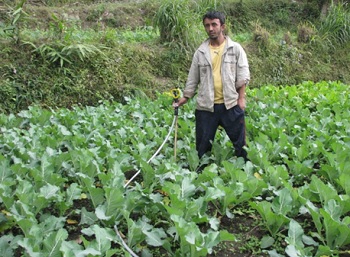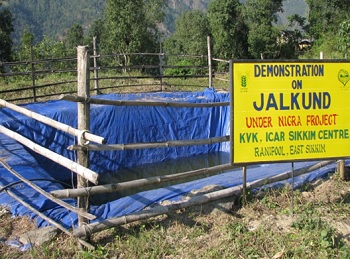Success story: Winter vegetable production through Jalkhund.
Nandok village is situated at the latitude of N 27017.818’ and longitude of E 0880 36.678’ with an altitude of 1133.5 m from asml in East district of Sikkim making it conducive for the cultivation of different types of horticultural crops. Nandok village of East district, Sikkim is adopted under National Innovative Climate Resilient Agriculture (NICRA)-TDC project. It receives a total annual normal rainfall of 3057.3 mm in kharif and 269.06 mm during rabi season. Similarly, during winter season experienced long dry during recent past and also no irrigation infrastructure exists in the village. Farmers face serious problems like shortage of water in the village due to extreme climatic factors such as rising temperature, untimely rainfall, and drought during peak demand of crop, hail storm and strong winds etc. After assessing the problems in the village, Krishi Vigyan Kendra, East Sikkim made interventions with the different activities under NICRA (Technology Demonstration Component) project to enhance the water use efficiency and thereby increase cropping area during winter season through life saving assured irrigation with the demonstration of climate resilient technology i.e., low cost water harvesting structure (Jalkund) during 2014-15.
KVK intervention
In order to enhance the cropping intensity of the village by exploring the best possible resource conserving technologies (RCTs) and using the low cost water harvesting structure were demonstrated during Rabi season. Krishi Vigyan Kendra, East Sikkim intervened and demonstrated low cost water harvesting reservoir (Jalkund) at farm of Mr. Tashi Lepcha of Nandok village under NICRA (Technology Demonstration) component during 2014-15. In this technology, a Jalkund was constructed on the upper part of the field for conserving the runoff rainwater during rainy season by digging a pit of 5 x 4 x 1.5 m and covered with a plastic lining of 250 GSM which accumulated around 30000 liters of rain water.
Mr. Tashi Lepcha, a progressive farmer volunteered to adopt the low cost farm pond technology in his land to harvest the rainwater and utilize during winter season. He constructed a Jalkund for rainwater harvesting in which the runoff of the village streams was also harvested and judiciously utilized as life saving irrigation for cole crops, vegetable seedlings, potato etc.
Impact of intervention
Before the intervention, Mr. Tashi Lepcha rarely cultivated second crop after maize and rice leaving the field fallow during rabi season due to uncertainty of rain and lack of irrigation facility. The returns from farming was very nominal. The availability of water for life saving irrigation encouraged him to diversify the cropping system with organic cole crops, vegetable pea and vegetable seedlings production under low cost structures during the Rabi season. Judicious use of Jalkund water to irrigate Rabi crops during dry spells with micro-irrigation systems (sprinkler) made vegetable production a profitable venture. It has increased the cropping intensity from 110 to 216 per cent and the net returns multiplied manifold from his 0.48 ha of net arable land. Mr. Lepcha is now a successful rural youth farmer showing the path to other farmers to manage mid-season drought through farm pond technology.
Crops Area (ha)
Production (kg) Gross expenditure (Rs.) Gross income (Rs.) Net income (Rs.) B:C ratio Cabbage 0.2 4,670 18,750 46,700 29,850 2.49 Cauliflower 0.1 1,430 9,200 21,450 12,250 2.33 Broccoli 0.1 980 8,560 19,600 11,040 2.28 Vegetable pea 0.06 540 3,270 10,800 7,530 3.30 Vegetable seedlings 0.02 58,600 seedlings 19,650 58,600 39,650 2.98 Total 0.48 58,630 1,58,950 1,00,320 2.68 Conclusion: Mr. Tashi Lepcha earned net returns of Rs. 1,00,320/- over a period of three months through judicious use of harvested rain water. Earlier, area under irrigation in the village was nil but with the demonstration of this technology by the KVK East Sikkim, Mr. Lepcha started growing winter crops in larger area because of continuous supply of water during off season too. Mr. Lepcha has already started collecting rain water in the structure which will be used for the irrigating in the Rabi vegetable crops with an area of 0.48 ha of his land during 2015-16.

